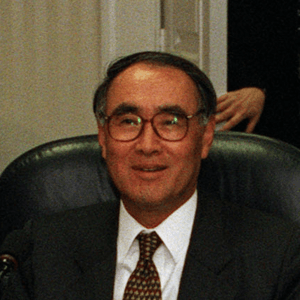Lee Hong-koo facts for kids
Quick facts for kids
Lee Hong-koo
|
|
|---|---|
|
이홍구
|
|

Lee in 1999
|
|
| Prime Minister of South Korea | |
| In office 17 December 1994 – 18 December 1995 |
|
| President | Kim Young-sam |
| Preceded by | Lee Yung-dug |
| Succeeded by | Lee Soo-sung |
| South Korean Ambassador to the United States | |
| In office 28 April 1998 – 1 August 2000 |
|
| President | Kim Dae-jung |
| Preceded by | Park Kun-woo |
| Succeeded by | Yang Sung-chul |
| Personal details | |
| Born | 9 May 1934 Keiki Province, Korea, Empire of Japan |
| Alma mater | Emory University (BA) Yale University (MA, PhD) |
| Lee Hong-koo | |
| Hangul |
이홍구
|
|---|---|
| Hanja |
李洪九
|
| RR | I Honggu |
| MR | I Honggu |
Lee Hong-Koo (Korean: 이홍구; Hanja: 李洪九; born 9 May 1934) is a South Korean who was a professor and later a politician. He served as the prime minister of South Korea from 1994 to 1995. Lee also worked as South Korea's ambassador to the United Kingdom and the United States. He helped start the East Asia Institute in Seoul.
Contents
Early Life and Education
Lee Hong-Koo's family comes from the Jeonju Yi clan. This was the royal family that ruled Korea for a long time, from 1392 to 1910. He was born in what is now part of Yeouido Island in Seoul, Korea, when it was under Japanese rule.
He grew up in Seoul and finished high school at the well-known Gyeonggi High School in 1953. That same year, he started studying law at Seoul National University.
Academic Career
Studying in the United States
In 1955, Lee went to Emory University in the United States. He studied political science and graduated in 1959. He then continued his studies at Yale University, earning his master's degree in 1961 and his PhD in political science in 1968.
From 1964 to 1968, he was a professor at Emory University. He returned to the U.S. in 1973 and 1974 to do research at the Woodrow Wilson International Center and Harvard Law School. Emory University gave him an honorary doctorate degree in 1978.
Teaching in Seoul
Around 1968 or 1969, Lee came back to Korea. He became a political science professor at Seoul National University, which is one of Korea's top universities. He taught there until 1988, when he became a government minister.
Political Career
After teaching for 33 years, Lee Hong-Koo began his career in government. In 1988, President Roh Tae-Woo chose him to be the unification minister. This role involves working on relations between North and South Korea.
In 1991, President Roh also appointed Lee as the South Korean Ambassador to the United Kingdom. From 1994 to 1995, Lee served as the 28th Prime Minister of South Korea under President Kim Young-Sam. In Korea, the President has more power than the Prime Minister. At this time, Lee was not part of any political party.
Joining a Political Party
In 1996, President Kim Young-Sam suggested that Lee Hong-Koo join the New Korea Party. Lee then became a candidate for this party in the upcoming National Assembly elections.
The New Korea Party was a new name for a group of conservative and moderate political parties that had joined together earlier. Lee Hong-Koo was elected as a member of the National Assembly in the April 1996 election. He was placed high on the party's list, which meant he was guaranteed a seat. The New Korea Party won many seats in that election.
Rising in Politics
Lee quickly became important in 1996. He joined the Executive Committee of the New Korea Party and then became the leader of the party itself. Many people thought he might become the next President after Kim Young-Sam.
From 1995 to early 1996, Lee was the chairman of the committee that worked to bring the World Cup to South Korea. His efforts helped South Korea co-host the 2002 FIFA World Cup with Japan in May 1996.
In December 1996, Lee Hong-Koo stepped down from his top leadership role in the New Korea Party. He remained a member of the party.
After the Asian economic crisis began in 1997, Kim Dae-Jung won the presidential election. When Kim Dae-Jung became President in February 1998, Lee Hong-Koo was still a member of the National Assembly. His party was now called the Grand National Party.
Ambassador to the United States
On March 24, 1998, President Kim Dae-Jung chose Lee Hong-Koo to be the South Korean Ambassador to the United States. This was a big deal because Lee was a key figure in the previous government's party. This choice showed that the new government wanted to work together across different political groups on foreign policy.
Lee Hong-Koo served as ambassador to the U.S. for two and a half years, from May 1998 to August 2000. During this time, South Korea had the "Sunshine Policy" which aimed to improve relations with North Korea.
Life After Politics
Lee Hong-Koo was involved in government and diplomacy for 12 years, from 1988 to 2000. After returning to private life in 2000, he became a newspaper writer and worked with think tanks. He joined the Club of Madrid, a group of former heads of state and government. He also helped start his own think tank.
Starting the East Asia Institute
In May 2002, Lee Hong-Koo founded the East Asia Institute (EAI). This is an independent, non-profit group in Seoul that studies politics and foreign policy. By the 2010s, EAI was known as one of the top think tanks in the world.
Lee Hong-Koo was the Chairman of the Board at EAI for ten years, retiring in May 2012 when he turned 78.
See also
 In Spanish: Lee Hong-koo para niños
In Spanish: Lee Hong-koo para niños

